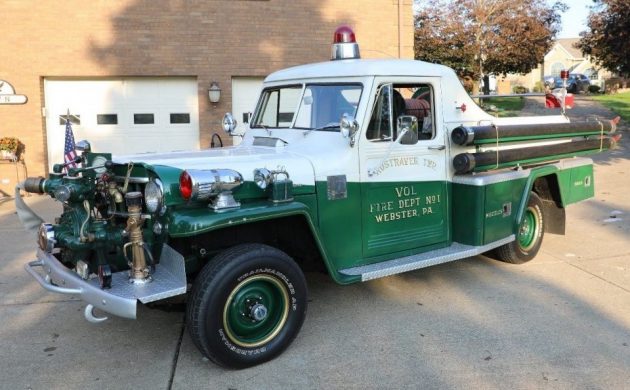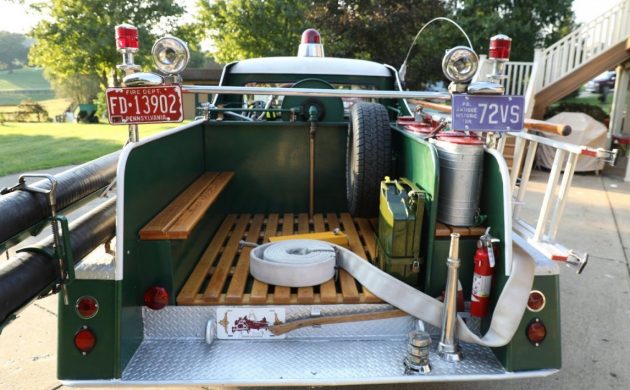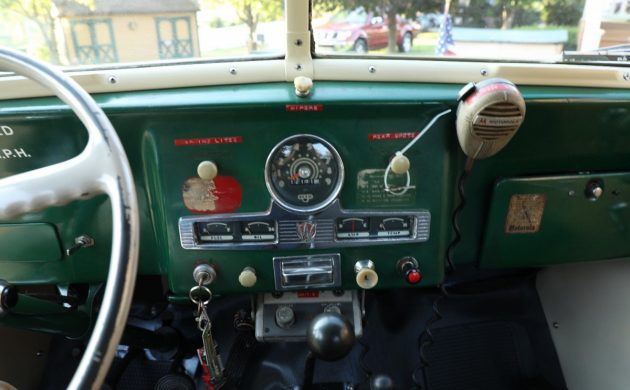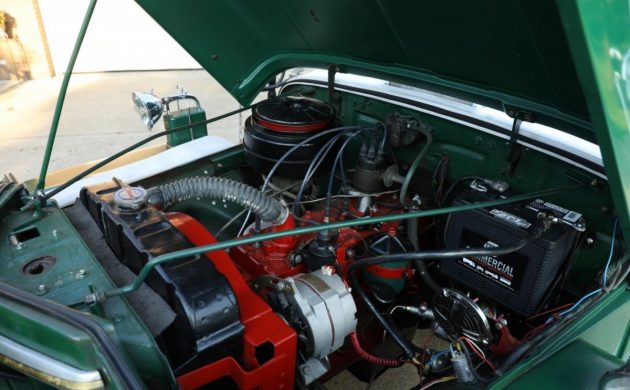I can’t recall ever seeing a fire department with a rig this nice, but perhaps this 1955 Willys really did look this good when it was new. The seller does a bang-up job of listing every new part that’s been added but doesn’t say much about its history – which, to me, is the most appealing aspect of a vintage fire truck like this. Find the listing here on eBay where the seller has a $20,000 Buy-It-Now and the option to submit an offer.
Seeing the elaborate setup of lights, bars, hoses, and more lights makes the Willys almost appear delicate as if it’s too technical to be used a tool at the site of a three-alarm blaze. That’s not to say that a fire apparatus isn’t a technical machine, it is – but there’s also easy access for every tool and device needed, with no need to worry about damaging the wood slats in the bed. If you’re looking for a rough and tumble Willys, check out our recent Exclusive!
Even the dash appears to have too much going on and should make modern firefighters thankful that today’s engines have huge cabs with plenty of space for passengers and equipment. The seller tells us very little about this Willys’ past, and we have to ascertain based on the door script that it was once used by the volunteer division of the fire department in Webster, Pennsylvania.
The seller has done a good job of cataloging all of the new parts, which is far-reaching and includes lock-out hubs, alternator, horn, hood panel, muffler, shocks and more. The Willys is almost certainly destined for the local parade route, but if its heritage can be proven, I could see it in a museum setting as well. Would you use this as a cruiser or is it destined to be an exhibit somewhere?







This looks like an operating unit here. That upside down steering wheel, indicates to me, a worn steering box, ( like my Willys’) and the 45 mph limit should probably be adhered to. That’s quite a pump on the front, and more likely used as a transfer unit, from a pond to a tanker, or on site tanker to an engine. With the small tank onboard, it wouldn’t last long in an inferno. Matter of fact, the onboard tank probably just keeps the Jeep from burning while pumping. With all the wildfires, it would seem a shame to split this up. With 12K miles, it probably saw more parade duty than fire fighting. Or donate it to some 3rd world country, heck, probably be the nicest truck in their fleet.
The Jeep was bought by Rostraver Vol Fire Dept. For fighting brush fires off roads. It was used for that purpose. The front 500 GPM I didn’t know it was sold.i went to the Navy and didn’t go back to the fire Dept. My address is 3020 Midway Rd. Rostraver TWP, PENNSYLVANIA. Webster it located in Rostraver Twp.!!
The problem with fire trucks is they are perpose built and when they’re decommissioned their kind of useless. They take up a lot of room to store and it would be a crying shame to leave this truck outside. I hope the new owner will be happy with his purchase and has room to store it indoors.
Didn’t that engine only put out 90 HP? You probably wouldn’t be the first to arrive at the scene of the fire with this rig, but you’d arrive in style!
LOL Ikey. I have the same motor in my 1960 Willys Utility Wagon. The 226 Flathead 6. 90 horse is right. I am flying at 50! Nice motor but, I have yet to arrive in style! Take care Bud. Mike.
I did forget to add, Nice find and nice story Jeff. This is a pretty girl looking through my rose colored glasses. With that bench seat and the flat area in the back it would be a great deer hunting rig also. Not sure why you would need a 6 volt alternator though, never had a problem with charging with my 12 volt generator. Great post Jeff, thanks, Mike.
I never had a problem with generators either. Maybe with the extra lights and siren, it taxed the 6 volt system.The advantage( I believe) of alternators, is they put out full charge at low rpms, unlike a generator.
I’m a firefighter so I have some knowledge of this topic. This was a front-line brush or forestry truck. They’re made to put out or stop the spread of small brush or forest fires. They operate at low pressure usually at the edge of the fire. Everything was small including the tank and pump to make it lighter and more maneuverable in tight areas off road (also why it’s 4×4). It would likely only carry 2 or 3 firefighters. The hard suction hoses mounted on the outsides of the bed are for drafting from small bodies of water to refill the tank. This would be left in the engine bay on any type of structure fire unless it happened to start adjacent brush or forest on fire. As far as the 6 volt system, the chief or whoever was in charge of ordering the truck could have specified almost anything they wanted including a 6 volt electrical system. Nice truck.
These units were designed to be used by smaller departments as well as industrial uses for both structural fires as well as grass and brush fires I am a 26 year veteran of the fire service I also happen to own a twin to this unit. It is capable of 500 gpm at 250 PSI which was considered a class a pumper when the nfpa standards were first developed. In the time of this unit’s production it came standard with a 6 volt electrical system which was common in 1955, especially with the willys chassis. I recall as a child seeing my unit responding with 2 firefighters in the cab as well as 2-3 on the tailboard. The alternator is more than likely a later change because of charging issues with the added emergency lights while idling or participating in parades, I actually have done the same thing to mine. A single wire alternator works great for this purpose just rev it up to excite the plates and it will produce full power as long as it spins. More info on these trucks is available on the CJ3b webpage. From the looks the electrical system on that one is also 6 volts as there are 3 caps on the battery for adding water (one for every 2 volts) which is the same as my truck. I did just read the story from the former firefighter and I know the department which purchased my unit purchased it as an additional pumper for Insurance ratings but later the story newer firefighters would say they thought it was purchased only for grass fires. I had the privilege of speaking to my grandfather who was on the department when it was delivered and I also have photos of mine being used on a large marina fire. As a child I recall it being used on a rail yard fire as well.
Many automotive manufacturers had switched over to 12 Volts by 1955, but Willys didn’t make the leap until late 1957. However I’m sure when the truck was constructed, it was an easy request to ask that it be built as 12 volts.
Now let’s look at all the electrical equipment on the truck IN ADDITION TO ALL THE STANDARD LIGHTS, ETC;
It’s got FOUR spotlights, a roof revolving light with 2 light bulbs and an electric motor, plus that big Federal Sign & Signal combination siren and light, and that may well have a rotating motor for the front light too. That unit alone can soak up 15 to 20 amps. It’s got a tube-type 2-way radio too. 2 more round mini rotating lights high up at the rear corners with motors.
One of the reasons for going to 12 volts was the simple reality that compared to light bulbs, electric motors take up a lot of power [amps] to run, and they use up more amps at low voltage than higher voltage. By the mid 1950s American cars were adding electrical motors & solenoids to their cars every year, from A/C systems [compressor clutch & blower motors], power windows, power door locks, trunk unlock mechanisms, wiper motors, dual power antennas, and more. Even Trico added a small electric pump motor to their windshield washers, something that had been a vacuum system before.
If this truck has to sit idling for long periods of time during a fire, a generator at idle simply can’t put out enough amperage to keep the battery fully charged, so it’s logical for the truck to be ordered new with a 60 to 80 amp commercial alternator, probably a Leece-Neville or similar unit that are a lot larger than the modern version seen in the photos.
And for those who would suggest vehicle alternators were not available back then, Henney-Packard began offering the Leece-Neville alternator on their ambulances as early as 1952 or 53.